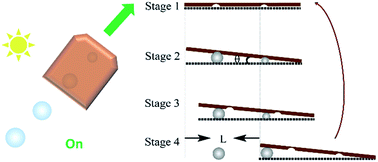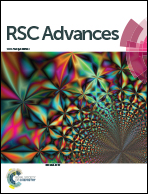Light-controlled two-dimensional TiO2 plate micromotors†
Abstract
In this work, UV light-controlled two-dimensional (2D) TiO2 plate micromotors are demonstrated for the first time. The 2D TiO2 micromotors are produced by the well-known anodic oxidation method in combination with a cracking and separation process. When the motor is placed in H2O2 aqueous solution under UV irradiation, oxygen bubbles are generated in the holes of the TiO2 membrane. The 2D micromotor thus moves upon O2 bubbles under its own weight. In contrast to bubble-propelled micromotors, which require an addition of surfactants to chemical fuels, the 2D micromotor is capable of moving in aqueous H2O2 solution without surfactants. Moreover, speed of the 2D TiO2 micromotor can be controlled by the intensity of the UV light. Such surfactant-free micromotors and their facile fabrication hold considerable promise for diverse practical applications in the biomedical and energy fields, for example, and in new materials.



 Please wait while we load your content...
Please wait while we load your content...